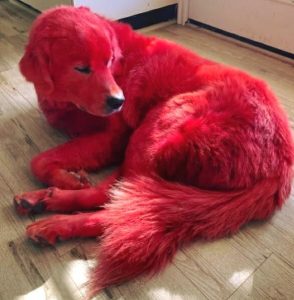Woman dyes her Great Pyreneese dog bright red so he won’t get stolen
Many dog owners have concerns about the safety of their beloved pets, especially when it comes to the possibility of dognapping. Rare and expensive dog breeds, in particular, can be attractive targets for thieves looking to make a quick profit.
One woman’s unconventional approach to protecting her dog has sparked significant online debate, with opinions divided on whether her actions are justified or questionable.
Chloe is the owner of Dandy, a 2-year-old Great Pyrenees with a striking and rare appearance: his fur is bright red, a result of pet-safe dye applied by Chloe herself.

Her decision to dye Dandy’s fur has attracted both praise and criticism on social media platforms, particularly on TikTok. Many viewers were concerned about the potential health risks of dyeing a dog’s fur, expressing sympathy for the dog with comments like “poor dog.” On the other hand, some users have embraced Dandy’s bold new look, even comparing him to the famous character Clifford the Big Red Dog.
Chloe, in response to the backlash, reassured her followers that she only uses vegan, pet-safe dye, reportedly Opawz products, specifically designed for animals. In a series of follow-up videos, she explained the reasons behind her decision. One of her primary motivations was to “keep him from getting stolen” since the Great Pyrenees breed is considered rare in her area. Chloe also mentioned that Dandy seems to enjoy his new color, as he loves interacting with people and children, and the red hue apparently makes him seem “more approachable.”

Another reason Chloe shared was her desire to “educate others on safe pet dye practices.” She even posted tutorials on how others could dye their own dogs’ fur safely, emphasizing the importance of using pet-friendly products and following correct procedures.
Dandy’s TikTok account, which boasts over 10 million likes and more than 318,000 followers, has continued to generate considerable debate. Some critics question whether the dyeing process is genuinely for the dog’s safety or merely a strategy to attract online attention. They argue that the bright red color would likely do little to deter potential thieves and might be more about generating buzz on social media.
However, supporters of Chloe’s decision defend her actions, pointing out that Dandy appears happy, healthy, and well-cared for. They argue that since Dandy doesn’t understand his color, the dye is unlikely to have any negative impact on him. Supporters also maintain that as long as the dye is safe and humane, it’s ultimately up to the owner to make such decisions for their pet.
Despite the ongoing debate, Dandy’s TikTok account has been inactive since February, and the most recent update on his Instagram dates back to July. The post shows Dandy’s fur has faded back to its natural color, and Chloe mentioned that he “needs a touch-up.” Whether or not Dandy will be re-dyed remains uncertain, as many of her followers have commented, urging her not to reapply the dye and to let him remain in his natural color, which they find more appealing.

This situation raises important questions about the balance between pet ownership, safety, and the boundaries of personal expression. Is dyeing a dog’s fur a fun, harmless way to keep a pet safe, or does it cross a line into unnecessary and potentially harmful treatment?
While some may argue that it’s an inventive solution to an ever-growing issue of pet theft, others view it as an impractical and possibly attention-seeking choice. The decision ultimately rests with the pet owner, but it also invites a broader conversation about what is best for the animal and what is truly in its best interest.
What are your thoughts on Chloe’s decision to dye Dandy bright red? Do you think it’s a clever way to keep him safe, or do you see it as a case of unnecessary cosmetic alteration? Should pet owners have more freedom in expressing themselves through their pets, or is there a responsibility to ensure pets’ well-being above all else?

